Keeping Your Antique Furniture Ship
Shape
by Bob Brooke
If you’re a collector of
antique furniture, you no doubt have invested considerable time and
money into your collection. Once many people acquire pieces of antique
furniture, they tend to forget about them. Unlike today’s furniture,
which in most cases is protected by several coats of polyurethane
varnish, antique pieces have only a coat or two of traditional varnish
to protect them, so damage and deterioration is inevitable.
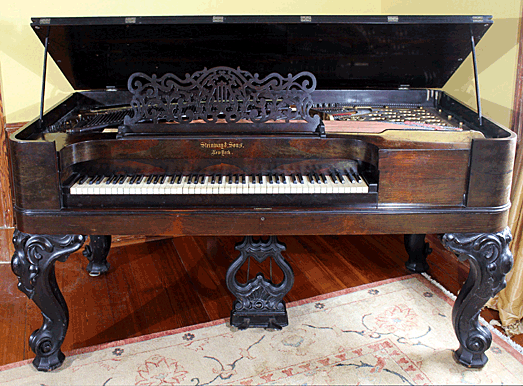
Once a piece gets too bad over time, it needs to be restored, which can
be costly. To prevent that added expense and to make sure your pieces
hold their value, you should practice routine maintenance.
Begin by dusting your furniture with a clean, dry, soft cloth once a
week. This prevents dust and dirt buildup. If you need to use any sort
of cleaner, spray some Windex or other glass cleaner on your cloth first
to just dampen it. DO NOT use lemon oil or any of the spray furniture
polishes.
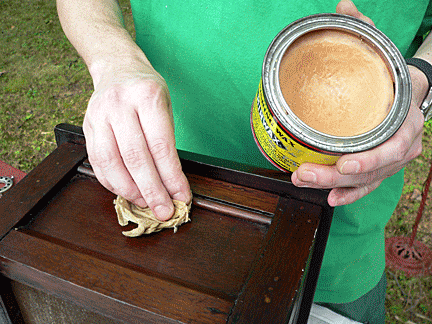 Besides
cleaning your furniture regularly, you should also wax it with Minwax
Paste Wax once a year. If the furniture gets heavy use, give it two
coats. First dust the piece, then coat it with wax. Let it dry as per
instructions on the can, then buff it with old face towel. Before giving
it a second coat, rub the piece all over with #0000 steel wool, then
dust off the piece once again before applying the second coating of wax.
Finally, buff to a soft shine. Besides
cleaning your furniture regularly, you should also wax it with Minwax
Paste Wax once a year. If the furniture gets heavy use, give it two
coats. First dust the piece, then coat it with wax. Let it dry as per
instructions on the can, then buff it with old face towel. Before giving
it a second coat, rub the piece all over with #0000 steel wool, then
dust off the piece once again before applying the second coating of wax.
Finally, buff to a soft shine.
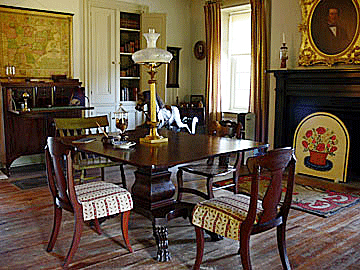 You’ve
probably noticed that historic houses keep their rooms somewhat dim,
protected from too much sunlight by draperies or shades. This is because
strong sunlight will fade the pigment in the wood and damage the finish.
Strong light will also fade upholstery and cause the fabric to
deteriorate faster. When possible, close blinds and curtains during the
day and remember to rotate your furniture once a year. You’ve
probably noticed that historic houses keep their rooms somewhat dim,
protected from too much sunlight by draperies or shades. This is because
strong sunlight will fade the pigment in the wood and damage the finish.
Strong light will also fade upholstery and cause the fabric to
deteriorate faster. When possible, close blinds and curtains during the
day and remember to rotate your furniture once a year.
Also, don't use a table runner or centerpiece on your dining table for
long periods of time if it sits in strong light. When you remove the
centerpiece, you’ll notice a difference in color where the centerpiece
sat and it generally isn’t repairable.
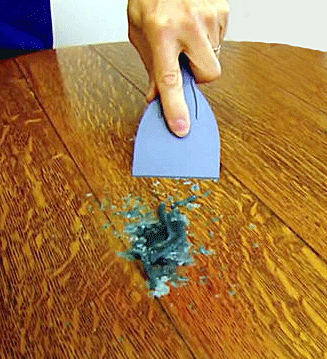 Never
place plastic covers directly on your wooden furniture. The plastic, if
left for any length of time, will adhere to your furniture and might
pull the finish off when you try to remove the cover because the
solvents in the plastic are the same as the solvents in the finish. Never
place plastic covers directly on your wooden furniture. The plastic, if
left for any length of time, will adhere to your furniture and might
pull the finish off when you try to remove the cover because the
solvents in the plastic are the same as the solvents in the finish.
Also, never set colored candles directly on your antique furniture
especially if it’s light colored. The color may bleed through the finish
and into the wood. Always use a candleholder or place a dish under them.
Occasionally, white rings or other marks may appear on your furniture.
Don’t panic. A white mark usually means that moisture has been trapped
in the finish and if left alone with disappear on its own. Whatever you
do, don't try using mayonnaise or cigarette ashes or oil to remove the
mark. If a white ring or mark doesn't go away by itself within two days,
contact a professional furniture refinisher.
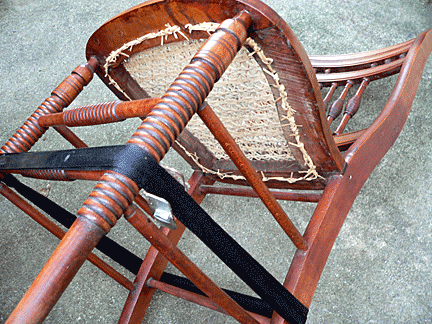 You
can easily tighten and re-glue the loose rungs on wooden chairs, but you
must have the right tools. To do this properly, you’ll have to pull the
rung out of its hole and sand the old glue off. You may have to wad up a
piece of sandpaper and do the same inside the hole. After you’ve cleaned
the end of the rung and the hole, apply some wood glue inside the hole
and replace the rung. Tap the opposite end of the rung with a rubber
mallet to make sure the rung is all the way in. Gluing without clamping
i You
can easily tighten and re-glue the loose rungs on wooden chairs, but you
must have the right tools. To do this properly, you’ll have to pull the
rung out of its hole and sand the old glue off. You may have to wad up a
piece of sandpaper and do the same inside the hole. After you’ve cleaned
the end of the rung and the hole, apply some wood glue inside the hole
and replace the rung. Tap the opposite end of the rung with a rubber
mallet to make sure the rung is all the way in. Gluing without clamping
i s
the same as not gluing. To clamp the chair correctly, you’ll need a
fabric clamp—this looks like a red fabric belt with a buckle on one end.
Wrap the clamp completely around all four legs of the chair and insert
the empty end into the buckle. Then clamp it shut. Let the glue set for
at least 24 hours, then remove the clamp. s
the same as not gluing. To clamp the chair correctly, you’ll need a
fabric clamp—this looks like a red fabric belt with a buckle on one end.
Wrap the clamp completely around all four legs of the chair and insert
the empty end into the buckle. Then clamp it shut. Let the glue set for
at least 24 hours, then remove the clamp.
Finally, don’t use soap on the bottoms of drawers to get them to open
and close smoothly. First, pull out the problem drawer, empty it and
check the sides, the bottom and the back. If there are no loose parts,
then sight down the bottom on the drawer sides to see if the wooden
runners are worn out. If worn out, hire a furniture professional to
rebuild them. If everything looks okay, spray some silicone on the
runners, being careful not to get any on the front of the drawer, and
put it back in. The drawer should work smoothly again.
A little routine maintenance can go a long way with your antique
furniture. Keeping it in ship shape will ensure that it lasts a long
time and will hold its value.
<
Back to Caring for Your Collections
Archives
Next Article
> |
